Optometrists are a generous bunch. There is no shortage of stories to write about O.D.s who give of their time, their hearts, their wallets, and themselves.
With that in mind, weve selected a handful of optometristsall nominated by our readerswho characterize this generous spirit. They represent different humanitarian organizations; some that you know, such as Volunteer Optometric Services to Humanity (VOSH), and others you may not have heard of yet. They started their humanitarian work at different times in their careers; one soon after she graduated, another when he retired.
One thing these doctors have in common: They hope to inspire other optometrists to go out and give charitably of themselves. What you get, they say, is often greater than what you give.
VOSH Veterans
V.E. Bud Falkenhain, O.D., was on his first trip to Nicaragua in 1977his first trip with VOSHwhen he had a simple but life-changing experience. One of his first patients on that trip was an -8.00D myope. He put glasses on this young lady and led her to the window to take a look.
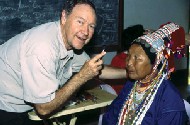 |
| Dr. Bud Falkenhain gives an eye exam to a woman of the hill tribes of Cambodia. |
Since that experience, Dr. Falkenhain has ventured from his Rolla, Mo., practice to make over 35 VOSH trips (at least one or two a year) to more than 20 different countries. Many of those trips have been to dangerous, war-ravaged countries such as El Salvador, Bolivia and Cambodia, among others. His most harrowing moment: In Guatemala, the army pulled him and his fellow passengers off a local bus and held them at machine-gunpoint for a few tense minutes.
Such perils are unfortunately commonplace in the most remote parts of the world, where the poorest of the poor live. Its those places where VOSH is needed most, he says. So thats where its missions go. In July, for example, Dr. Falkenhain will lead a trip to Outer Mongolia.
In some third-world countries, its actually easier to get an eye operation than to get a pair of glasses, he says. When you provide patients with glasses, they cant thank you enough. And the most thankful patients are the older ones, whose lives are changed by a simple pair of reading glasses.
Dr. Falkenhain followed in the footsteps of the late Franklin Harms, O.D., who founded VOSH in the early 1970s. As the third president of VOSH in the early 1980s, Dr. Falkenhain helped to expand the number of VOSH members and chapters, and was also the founder of the Missouri chapter. He helped establish VOSH/International as an active nonprofit organization with a board of directors. In 1985, Dr. Falkenhain received the Volunteer Action Award from President Reagan.
When we started this there were only a handful of people doing international work [in eye care]. Now there are many, many groups doing it, Dr. Falkenhain says. Its really grown a lot. But it still has a lot of room to grow.
Harry I. Zeltzer, O.D., retired from practice before he embarked on a career as a volunteer. During his years in private practice outside of Boston, Dr. Zeltzer advanced the science of color vision and invented the X-Chrom contact lens for color deficiency. Meanwhile, he planned carefully for his retirement, which he began in 1985 at the age of 55.
Since retirement, Dr. Zeltzer has made 42 missions to all parts of the world. He averages about three or four trips a year to places such as the Yucatan in Mexico, El Salvador, the Ukraine, as well as to underserved places in the U.S. like the hills of Appalachia and pueblos of Arizona.
I feel that optometrists have a great deal to contribute to the third world, he says simply.
An optometrist may see 100 patients during just one of these ten-hour days, Dr. Zeltzer says. And as a primary eye-care provider, its an education. You see a lot of eye conditions in a third-world country that you wouldnt see in the developed world, he says.
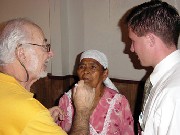 |
| In San Miguel, El Salvador, Dr. Harry Zeltzer (left) examines a patient with pterygium. |
He seems particularly proud of aligning optometry with ChildSight, a program through Helen Keller Worldwide that provides screenings and eyeglasses to children both in the U.S. and abroad.
Hes also the VOSH webmaster (www.vosh.org), a site that got a shot in the arm in 2001 thanks to a grant from Vistakon. In 2002, he was awarded New England College of Optometrys Alumnus of the Year. In 2003, he received the Essilor Humanitarian Award at UNESCOs First International Congress for Development of Visual Health.
Even now at age 74, Dr. Zeltzer is still on the move. In 2004, hes already been to El Salvador and Honduras, and he has more trips planned into next year.
Dr. Zeltzer says he does it for selfish reasons. Helping others makes him feel fulfilled. It makes me feel more complete, he says. My hope is to inspire other optometristsespecially young optometriststo recognize their value in helping people who need their assistance.
Special Olympics O.D.s
Paul Berman, O.D., of Hackensack, N.J., began what is now the Special Olympics Lions Club International Opening Eyes (SOLCIO) program as a project of the AOAs Sports Vision Section in 1989.
Oftentimes, when a person with mental retardation cant do something, we think its just their mental disability causing the deficit in performance, Dr. Berman says. The athletes vision is rarely considered and often neglected, which can have a very significant negative impact on the athletes performance in life.
The programs first screening, at the 1991 Special Olympics, found that more than 66% of the athletes had not been examined in the previous three years and over 37% needed a significantly different prescription than they were currently wearing. Whats more, the visual needs of these athletes in the U.S. are comparable with those of such athletes from other countries, indicating this populations visual needs are neglected around the world.
In addition to the numbers of athletes who need spectacle correction, about 18% need a referral for some acute or chronic condition. To that end, the program was expanded at the 1995 World Games to provide the athletes with clinical care and eyewear on-site.
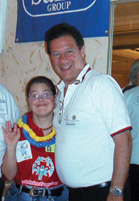 |
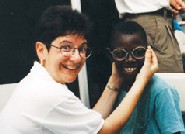 |
| Dr. Paul Berman started a small, but now big, Special Olympics eye care program. | Smiles abound as Dr. Susan Danberg gives glasses to a Special Olympian. |
Dr. Berman also obtained commitments from Essilor Labs to provide ophthalmic lenses, from Safilo to provide frames and from Liberty Optical to provide RecSpecs so that athletes can be protected while competing in sports. The retail worth of these contributions is in excess of $11 million.
Its not about pity, Dr. Berman says, Its about acceptance.
Susan Danberg, O.D., of Glastonbury, Ct., came on board at the 1995 World Games, and is now the global clinical advisor. She recalls asking one athlete, a -4.00D myope, how he was able to see to run a race. He said he just kept his eyes on the runner in front of him.
When Dr. Danberg first started, she was happily surprised by this kind of can-do spirit among these athletes. It changed a lot of my attitudes about what people with disabilities are capable of, what theyre like, she says. Its been a profoundly rewarding experience, both personally and professionally. I think I am a much better clinician because Ive been involved in this program, she says.
To date, SOLCIO has nearly 100 programs in the U.S. and internationally, has screened more than 44,000 athletes worldwide, and dispensed over 17,285 pairs of glasses at no cost to Special Olympics athletes and their families.
But its not just the Special Olympics athletes who benefit from the SOLCIO program. The organization has trained nearly 8,500 optometrists and students to provide vision care to people who have mental retardation. At each event, a continuing education seminar familiarizes doctors with the information necessary to provide the best vision care to this population.
Full-Time in Honduras
Valerie Colby, O.D., moved to Honduras nearly four years ago to run a combination medical and eye clinic. In the company of her husband Trevor and daughter Cecilia (and another baby on the way), Dr. Colby treats middle- and low-income patients in the hills outside of the nations capital, Tegucigalpa.
Dr. Colby is a deeply religious person, and that faith guides her in what she does. So far, she says, things are going great. It might seem a bit crazy to move to a third-world country when I could be making good money in the States, she says. But we love living here and wouldn"t trade it for anything.
In Honduras, Dr. Valerie Colby followed her faith to found a medical/eye care clinic.

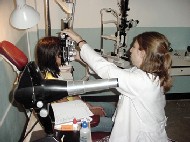
Its a long way from her hometown of Rossville, Ind. But even before graduating from Indiana University in 1999, Dr. Colby had already taken several week-long mission trips to Honduras through FCO, Fellowship of Christian Optometrists. She and her husband then spent the summer of 1999 in Honduras setting up the medical/ eye clinic, which is funded through the Fellowship of Associates of Medical Evangelism (FAME), based in Indianapolis.
A Wal-Mart Optical, in Bloomington, Ind., donated to the clinic a full array of equipment that was only a few years oldstand, slit lamp, refractor, chair, projector, edger, and about 1,000 discontinued frames. Just goes to show that when the need is great, providence (through Wal-Mart) will provide.
Dr. Colby treats a lot of patients for common problems, such as dry eye, cataracts and presbyopia. Many children present with refractive amblyopia and allergic eyes, and adults come in with poor visiondue to retinal scars, uncorrected strabismus, congenital or traumatic cataractsafter incorrect or no information from the local hospital. Its immediately gratifying, she says, when a simple bottle of pilocarpine can relieve a patient (with Adies pupil) who couldnt be helped anywhere else.
Several times a year, eye-care groups from the U.S. visit and Dr. Colby takes them to remote parts of the country where no eye care is available. Many, many people here have never had their eyes examined, let alone wear glasses, she says. These group eye clinics not only help the eyes of Hondurans, but also help to open the eyes of visiting volunteers.
(Dr. Colby welcomes any O.D. interested in a short-term humanitarian trip to Honduras to contact her at rookshark@hotmail.com.)
Having a Ball
Karen F. Perry, O.D., hasnt traveled around the world as a volunteer. Her charity begins at home or actually in her Orlando, Fla., office, where she gives vision exams to needy children. She also provides eye care to the homeless in a nearby shelter.
Dr. Perry says she just wants to provide eye care to those who seem to really need it, but for some reason cant get it. One way she does this is by organizing a formal charity ball almost every year. The funds raised by this Eye Ball go to various charities such as Prevent Blindness Florida, the Center for Independence and Technology (CITE) and the Fidelco Guide Dog Foundation. The event raises an average of $20,000 each time its held. That may sound like a lot for a one-night fundraiser, but its only enough to buy one guide dog for the blind, Dr. Perry says.

Dr. Karen Perry stands with dignitaries and guide dogs at a charity Eye Ball.
In her practice (which she runs with her husband, Mark Perry, O.D.), she provides free eye exams to children from disadvantaged backgrounds through several organizations, including the Lions Club Right for Sight program, the Jeppeson Foundation, Vision USA and the Migrant Children Foundation.
Dr. Perry also makes time to visit the Coalition for the Homeless shelter in downtown Orlando. (The eye-care program was set up by fellow Orlando optometrist Brian Den Beste.) Treating the homeless makes you realize that misfortune can happen to anyone, Dr. Perry says. We forget how good we have it.
What does she get out of it? I can go in there and not worry about collecting fees or billing insurance, she says. I went in to the profession to provide true eye care and to really meet the needs of patients. Thats why I do it, to really enjoy that part of the profession, the purity of it.
Associate Editor Michelle Boyles contributed to this article.

